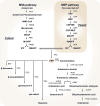Advanced metabolic engineering strategies for increasing artemisinin yield in Artemisia annua L
- PMID: 38414837
- PMCID: PMC10898619
- DOI: 10.1093/hr/uhad292
Advanced metabolic engineering strategies for increasing artemisinin yield in Artemisia annua L
Abstract
Artemisinin, also known as 'Qinghaosu', is a chemically sesquiterpene lactone containing an endoperoxide bridge. Due to the high activity to kill Plasmodium parasites, artemisinin and its derivatives have continuously served as the foundation for antimalarial therapies. Natural artemisinin is unique to the traditional Chinese medicinal plant Artemisia annua L., and its content in this plant is low. This has motivated the synthesis of this bioactive compound using yeast, tobacco, and Physcomitrium patens systems. However, the artemisinin production in these heterologous hosts is low and cannot fulfil its increasing clinical demand. Therefore, A. annua plants remain the major source of this bioactive component. Recently, the transcriptional regulatory networks related to artemisinin biosynthesis and glandular trichome formation have been extensively studied in A. annua. Various strategies including (i) enhancing the metabolic flux in artemisinin biosynthetic pathway; (ii) blocking competition branch pathways; (iii) using transcription factors (TFs); (iv) increasing peltate glandular secretory trichome (GST) density; (v) applying exogenous factors; and (vi) phytohormones have been used to improve artemisinin yields. Here we summarize recent scientific advances and achievements in artemisinin metabolic engineering, and discuss prospects in the development of high-artemisinin yielding A. annua varieties. This review provides new insights into revealing the transcriptional regulatory networks of other high-value plant-derived natural compounds (e.g., taxol, vinblastine, and camptothecin), as well as glandular trichome formation. It is also helpful for the researchers who intend to promote natural compounds production in other plants species.
© The Author(s) 2024. Published by Oxford University Press on behalf of Nanjing Agricultural University.
Conflict of interest statement
The authors have declared no conflict of interest.
Figures




Similar articles
-
GLANDULAR TRICHOME-SPECIFIC WRKY 1 promotes artemisinin biosynthesis in Artemisia annua.New Phytol. 2017 Apr;214(1):304-316. doi: 10.1111/nph.14373. Epub 2016 Dec 21. New Phytol. 2017. PMID: 28001315
-
[Advances in synthesis of artemisinin based on plant genetic engineering].Zhongguo Zhong Yao Za Zhi. 2019 Oct;44(19):4285-4292. doi: 10.19540/j.cnki.cjcmm.20190416.405. Zhongguo Zhong Yao Za Zhi. 2019. PMID: 31872711 Chinese.
-
Transgenic approach to increase artemisinin content in Artemisia annua L.Plant Cell Rep. 2014 Apr;33(4):605-15. doi: 10.1007/s00299-014-1566-y. Epub 2014 Jan 12. Plant Cell Rep. 2014. PMID: 24413765 Review.
-
Biotechnological Approaches for Production of Artemisinin, an Anti-Malarial Drug from Artemisia annua L.Molecules. 2022 May 9;27(9):3040. doi: 10.3390/molecules27093040. Molecules. 2022. PMID: 35566390 Free PMC article. Review.
-
TRICHOME AND ARTEMISININ REGULATOR 2 positively regulates trichome development and artemisinin biosynthesis in Artemisia annua.New Phytol. 2020 Nov;228(3):932-945. doi: 10.1111/nph.16777. Epub 2020 Aug 2. New Phytol. 2020. PMID: 32589757
Cited by
-
A transcription factor of SHI family AaSHI1 activates artemisinin biosynthesis genes in Artemisia annua.BMC Genomics. 2024 Aug 9;25(1):776. doi: 10.1186/s12864-024-10683-7. BMC Genomics. 2024. PMID: 39123103 Free PMC article.
-
Engineering Saccharomyces cerevisiae for medical applications.Microb Cell Fact. 2025 Jan 9;24(1):12. doi: 10.1186/s12934-024-02625-5. Microb Cell Fact. 2025. PMID: 39789534 Free PMC article. Review.
-
Comprehensive genome-wide analysis of the HMGR gene family of Asparagus taliensis and functional validation of AtaHMGR10 under different abiotic stresses.Front Plant Sci. 2025 Feb 20;16:1455592. doi: 10.3389/fpls.2025.1455592. eCollection 2025. Front Plant Sci. 2025. PMID: 40051869 Free PMC article.
-
Non-canonical plant metabolism.Nat Plants. 2025 Apr;11(4):696-708. doi: 10.1038/s41477-025-01965-3. Epub 2025 Mar 31. Nat Plants. 2025. PMID: 40164785 Review.
-
Advanced technologies in plant factories: exploring current and future economic and environmental benefits in urban horticulture.Hortic Res. 2025 Jan 27;12(5):uhaf024. doi: 10.1093/hr/uhaf024. eCollection 2025 May. Hortic Res. 2025. PMID: 40206515 Free PMC article.
References
-
- Kantele A, Jokiranta TS. Review of cases with the emerging fifth human malaria parasite, Plasmodium knowlesi. Clin Infect Dis. 2011;52:1356–62 - PubMed
-
- WHO . World malaria report 2022. https://www.who.int/news-room/fact-sheets/detail/malaria
-
- White NJ. The treatment of malaria. N Engl J Med. 1996;335:800–6 - PubMed
-
- Egmond R, Gool T, Grobusch MP. et al. . Fever after visiting the tropics: always exclude malaria. Ned Tijdschr Geneeskd. 2015;159:A8774 - PubMed
LinkOut - more resources
Full Text Sources
Research Materials

